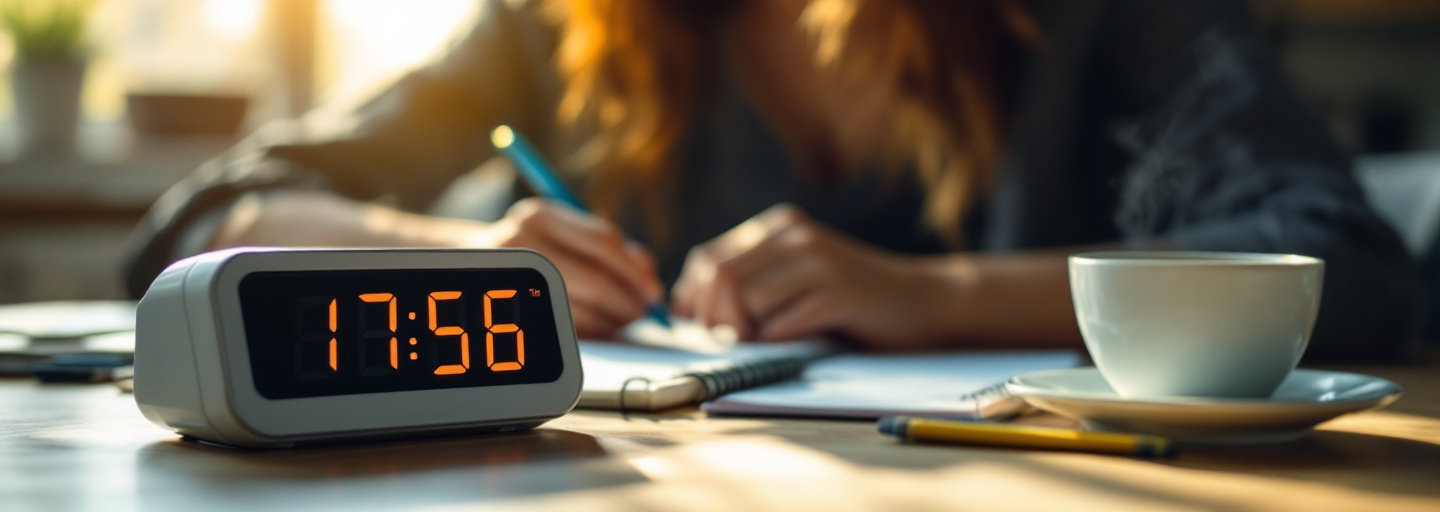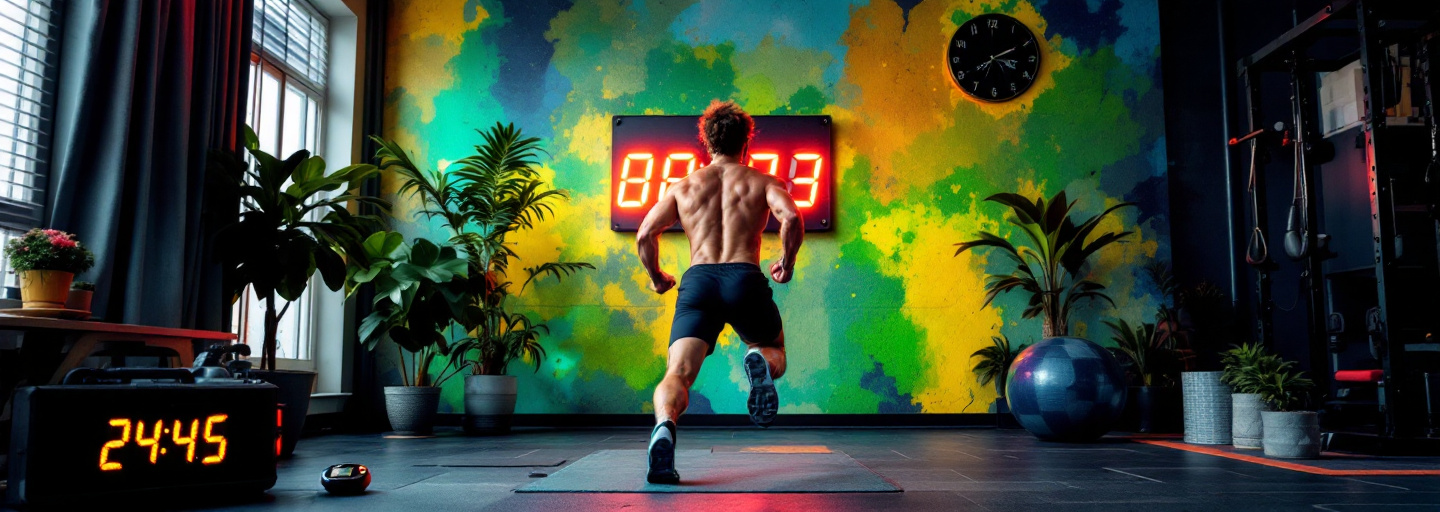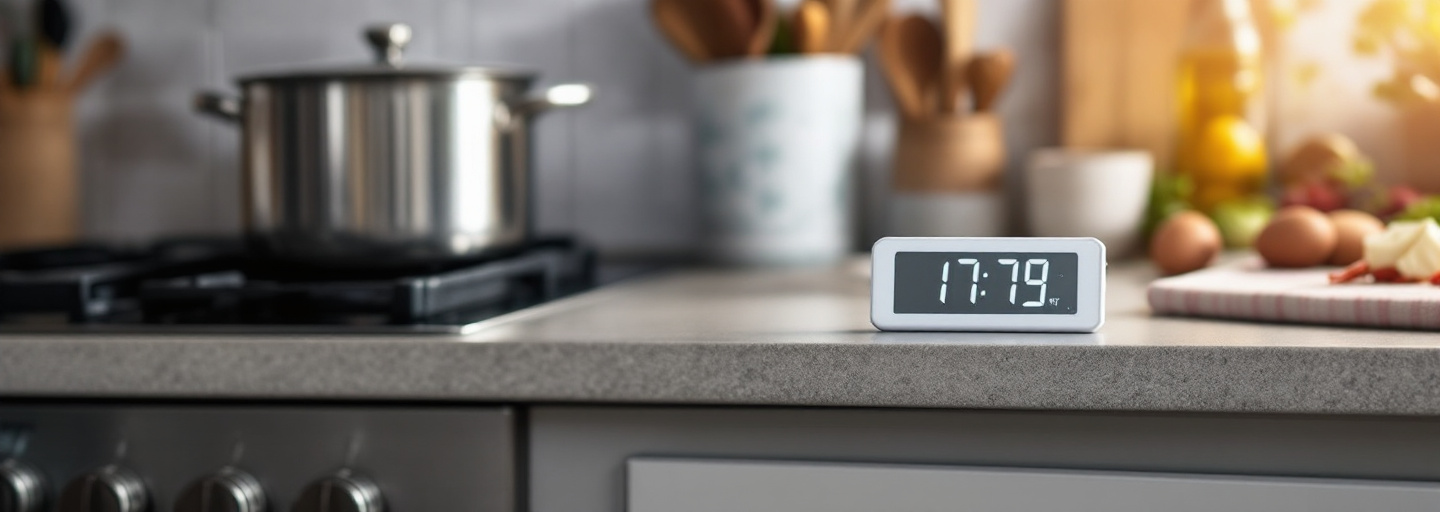Timers vs Stopwatches for Everyday Tasks
« Back to all blog postsLearn when to use timers or stopwatches for workouts, cooking, or study sessions to improve focus and productivity.

Understanding the Basics of Timers and Stopwatches
The average person loses 43 minutes daily on tasks that lack proper time boundaries. This productivity gap often stems from using the wrong timing tool for specific activities.
Timers function as countdown tools that begin at a preset time and work toward zero. When they reach zero, they signal that your set duration is complete. Think of baking cookies or limiting social media browsing.
Stopwatches operate in the opposite direction. They start at zero and count upward, tracking exactly how much time has passed with no predetermined endpoint. Athletes use these to measure race times or track workout progress.
The fundamental difference lies in their purpose: timers create boundaries and deadlines by counting down, while stopwatches provide measurement and tracking by counting up. This distinction determines which tool works best for specific situations.
Both tools have evolved from physical devices into digital versions available on smartphones, computers, and specialized apps. AlarmClockTab’s timer offers both functions in one convenient place, eliminating the need for separate tools.
When to Use a Timer for Better Focus
Time-Limited Activities
Timers excel at creating urgency for tasks with fixed durations. They provide clear endpoints that help maintain focus and prevent activities from expanding beyond their allotted time.
In cooking, timers ensure perfect results. A 4-minute timer guarantees soft-boiled eggs with runny yolks, while 7 minutes produces firm yet creamy centers. Baking bread requires precise timing for proper rising and browning.
Timers also prevent multitasking disasters. When you’re steeping tea, boiling pasta, and roasting vegetables simultaneously, a timer for each task prevents burnt food and kitchen chaos.
Structured Work Sessions
The Pomodoro Technique uses timers to boost productivity through 25-minute focused work periods followed by 5-minute breaks. This method works because the countdown creates a psychological boundary that improves concentration.
Knowing you only need to focus for a limited time makes starting difficult tasks easier. The timer creates urgency that helps overcome procrastination while preventing burnout through regular breaks.
Interval-Based Workouts
Timers structure exercise routines like HIIT or circuit training where precise work/rest periods matter. A 30-second work period followed by 15 seconds of rest requires exact timing for maximum effectiveness.
Preset timers eliminate the distraction of checking the clock, allowing full focus on exercise form and intensity. AlarmClockTab’s circuit timer helps maintain proper work/rest intervals for effective training without mental counting.
When to use timer instead of a stopwatch:
- When you need to limit time spent on social media
- For cooking multiple dishes simultaneously
- During timed tests or exams
- For managing speaking time in presentations
- When following structured exercise protocols
Best Situations to Use a Stopwatch
Performance Tracking
Stopwatches help measure and improve speed in activities where progress matters. Runners track their mile times, swimmers monitor lap speeds, and puzzle enthusiasts measure solving rates.
The key benefit lies in data collection over time. By recording your times, you create a progress record that shows improvement. A runner might start with a 10-minute mile and gradually improve to 8 minutes through consistent training.
AlarmClockTab’s stopwatch provides precise timing for tracking progress in various activities, allowing you to save and compare results over time.
Open-Ended Activities
Stopwatches shine when the duration isn’t predetermined. Creative work, brainstorming sessions, and exploratory learning benefit from measurement without imposed limits.
During a brainstorming session, a stopwatch tracks how long the process takes without cutting creativity short. This provides valuable data about your natural work rhythms without artificial constraints.
Similarly, when learning new skills, a stopwatch measures your natural pace without rushing the process. This creates awareness of time investment without creating pressure.
Process Analysis
Stopwatches help identify inefficiencies by measuring how long tasks actually take versus how long we think they take. This reality check improves planning and productivity.
Most people underestimate task duration by 40%. By using a stopwatch to track email processing, meeting participation, or report writing, you gather accurate data for future scheduling.
When to use a stopwatch instead of a timer:
- When tracking personal records in sports
- For measuring response times in customer service
- During scientific experiments requiring precise timing
- For logging time spent on billable work
- When analyzing how long routine tasks actually take
Timers vs Stopwatches for Workouts
Structured Workout Timing
Timers control interval training with precision. In HIIT workouts, a timer ensures you maintain exactly 30 seconds of high-intensity work followed by 15 seconds of rest.
Tabata protocols require 20 seconds of maximum effort followed by 10 seconds of rest, repeated 8 times. A timer maintains this strict pattern without mental counting, allowing full focus on exercise intensity.
Circuit training benefits from timers that signal when to move between stations. This eliminates the distraction of clock-watching and ensures consistent work periods at each station.
Performance Measurement
Stopwatch for workouts provides valuable data in endurance activities. Runners track their 5K times, swimmers monitor 100-meter splits, and cyclists record hill climb durations.
This tracking creates benchmarks for improvement. A cyclist might initially climb a specific hill in 12 minutes, then work to reduce that time through training. The stopwatch provides objective feedback on progress.
Stopwatches also help identify fatigue patterns. By tracking how performance changes throughout a workout, you can pinpoint when endurance begins to fade.
Combining Both Tools
Some workouts benefit from using both timing tools simultaneously. During circuit training, a timer controls station duration while a stopwatch tracks the total workout time.
In swimming workouts, a timer might control rest periods between sets while a stopwatch records total distance times. This combination provides both structure and performance data.
AlarmClockTab’s Tabata timer is specifically designed for high-intensity interval workouts with customizable work/rest periods, making it perfect for structured training protocols.
| Workout Type | Best Tool | Why It Works |
|---|---|---|
| HIIT/Tabata | Timer | Precise work/rest intervals need countdown function |
| Distance Running | Stopwatch | Tracks total time to complete a set distance |
| Weight Training | Timer | Controls rest periods between sets |
| Circuit Training | Both | Timer for station intervals, stopwatch for total workout time |
| Yoga/Stretching | Timer | Helps maintain poses for specific durations |
Choosing the Right Tool for Study and Work
Focus and Productivity Sessions
Timer for studying creates boundaries that combat procrastination. The Pomodoro Technique uses 25-minute work periods followed by 5-minute breaks to maintain focus without burnout.
This method works because the countdown creates urgency. Knowing you only need to focus for 25 minutes makes starting difficult assignments easier. The timer also prevents work from expanding endlessly.
Timers help manage energy throughout the day. By working in focused blocks with scheduled breaks, you maintain higher productivity levels than with continuous work.
Task Analysis and Planning
Stopwatches reveal how long tasks actually take versus your estimates. Most people underestimate task duration by 25-45%, leading to unrealistic schedules and unnecessary stress.
By tracking actual completion times for common tasks like email processing, report writing, or data entry, you gather data for more accurate future planning.
Stopwatches also help identify your peak productivity periods. By tracking work efficiency at different times of day, you can schedule important tasks during your natural high-energy windows.
Study and work timing recommendations:
- Essay writing sessions (Timer – sets boundaries)
- Reading assignments (Timer – maintains pace)
- Project planning (Stopwatch – measures task duration)
- Problem-solving (Stopwatch – tracks efficiency)
- Meeting management (Timer – keeps discussions on track)
AlarmClockTab’s Pomodoro timer helps implement this proven study method with customizable work and break periods, making it easier to maintain focus during long study sessions.
Timers in the Kitchen and Daily Routines
Cooking and Baking Precision
Kitchen success often depends on precise timing. Boiling eggs requires exactly 6 minutes for soft-boiled and 9 minutes for hard-boiled results. Steeping tea needs 3-5 minutes for proper flavor extraction without bitterness.
Baking demands even greater precision. Cookies need 10-12 minutes, bread requires specific proofing times, and caramel sauce can burn in seconds if left unattended.
Timers prevent the distraction of clock-watching, allowing you to focus on other kitchen tasks while ensuring nothing burns or overcooks.
Habit Formation and Routines
Consistent timing helps establish lasting habits. A 2-minute timer for tooth brushing ensures proper dental care. A 10-minute meditation timer prevents sessions from ending too soon due to restlessness.
Morning routines benefit from timers that prevent time-creep. A 5-minute shower timer helps maintain schedule discipline, while a 15-minute breakfast timer ensures you don’t run late.
Timers also help limit activities that tend to expand. A 20-minute social media timer prevents endless scrolling, while a 30-minute cleaning timer makes housework manageable.
Essential timer applications for daily life:
- Brewing coffee (3-4 minutes for pour-over)
- Morning routines (shower, breakfast, getting ready)
- Screen time limits for children
- Laundry cycles
- Quick cleaning sessions (15-minute room reset)
- Meditation and mindfulness practices
AlarmClockTab’s preset timers offer quick access to common timing needs without manual setup each time, making routine management simpler.
How to Decide Which Tool to Use
The fundamental question to ask yourself is: “Do I need to limit time or measure it?” This simple distinction points to the right tool for any situation.
Choose a timer when:
- You need to finish within a specific timeframe
- You want to limit time spent on an activity
- You’re following a structured process with defined durations
- You need an alert when time is up
Choose a stopwatch when:
- You want to track how long something takes
- You’re measuring performance or progress
- You need data about time spent for future planning
- You want to record elapsed time without interruption
| Ask Yourself | Choose Timer If… | Choose Stopwatch If… |
|---|---|---|
| What’s my goal? | Limiting time spent | Measuring time taken |
| Do I know how long it should take? | Yes, I have a target duration | No, I want to find out |
| What feedback do I need? | Alert when time is up | Record of elapsed time |
| What’s my focus? | Staying within boundaries | Tracking performance |
Digital stopwatch tools like those found on AlarmClockTab’s homepage provide easy access to both timers and stopwatches in one convenient location. This flexibility allows you to switch between timing approaches based on your specific needs without juggling multiple apps or devices.


